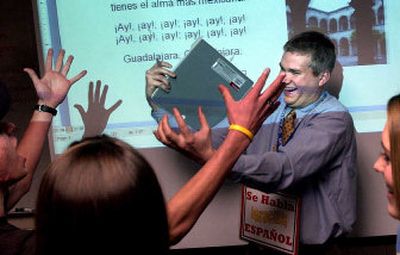Technology lets kids plug in

When it’s time for a quiz, students close their laptops and take out remote-control devices to punch in their answers.
In another classroom, students reinforce their foreign-language skills by playing rounds of customized computer “Jeopardy” and “Wheel of Fortune” on a projector screen.
Sound like schools from an episode of “The Jetsons”?
These scenes play out daily in the Coeur d’Alene school district.
A few teachers are on the front lines of integrating new technology into their instruction. The investments can be expensive, but an increasingly tech-savvy world and increased student participation make it worth it, they say.
‘More engaged’
In Paula Conley’s class, seventh-graders receive instant feedback on answers they key in on their “clickers,” which send data to a computer for immediate tabulating. Conley used the results during a recent session at Canfield Middle School to review common mistakes in apostrophe use.
Afterward, the students opened laptop computers to work on a research project comparing characters in the book “The Giver” with real-life, non-mainstream groups such as the Amish and Hasidic Jews.
“They’re much more engaged” when they use technology, Conley said. . “You have to meet the learner where the learner is,” she added, and today’s young people live in a digital world.
At Coeur d’Alene High School, Spanish teacher Mike Nelson echoed those sentiments.
“The kids are immediately drawn into it,” he said. “They know they’re going to be able to interact.”
Like Conley, Nelson uses clickers to conduct quizzes – and his students cheer and give high-fives when they get answers right. Nelson also uses computer software to create game shows for his students, who pass around a remote device called a School Pad when it’s their team’s turn to respond. Images on his computer screen are projected onto a larger screen at the front of the classroom for everyone to see, and students can control the computer using the School Pad.
Nelson creates PowerPoint presentations on vocabulary words, complete with a picture and example of usage, instead of writing a list on the board. He maintains a Web site and chats with students online in the evenings if they have questions on their homework.
Elise Fabiano, a sophomore in Nelson’s Spanish 3 class, is a visual learner and appreciates Nelson’s efforts to help students see the material in various formats.
“You learn a lot more that way,” Fabiano said.
She also likes the en masse, interactive nature of tools such as the clicker. “We all have input on every answer.”
Nelson plans to talk to his students while he’s in Mexico, using the school’s new distance-learning lab, equipped with cameras and large-screen televisions. He hopes technology will allow students in Coeur d’Alene to talk to teens in Guadalajara schools.
‘It’s a tool’
Technology puts the world at students’ fingertips, said Sheila Knox, the district technology facilitator. She writes technology-integrated curriculum and instructs teachers on how to implement it.
One of the challenges Knox sees is the extensive time and resources standardized testing takes up, leaving less for creative and project-based lessons. “I would love to see them used – and they are in many cases – for authentic learning, real-world learning.”
Another challenge is funding. School levies, state grants, local fundraisers and business donations have helped pay for equipment and software, but Nelson can attest that upkeep is an ongoing expense. He has bought about $40,000 worth of technology for his decked-out classroom, including some personal purchases.
Nelson makes sure he talks to his students about the limits of technology. Online translation tools are far from perfect, some Web sites are more reliable than others, and plagiarism – easier because of technology – is a risk.
Technology “is a trap for some kids as well,” Nelson said.
Conley makes sure her students prepare the old-fashioned way before she lets them get on a computer. If you put them in front of a screen immediately, she said, “you get garbage.”
“It’s a tool,” Conley said of technology. “It’s not a method of teaching.”
‘Part of life’
Lack of digital proficiency can be a barrier. Some teachers get intimidated when things don’t work, Conley said.
“Yeah, there’s something that might go wrong but there’s probably a kid who can fix it,” she added. “They’re not afraid to go in and click stuff.”
Her seventh-grade techie is Jimmy Keith. His take on technology is this: “It makes learning a little more fun because you get a little more interaction. It makes class a little more enjoyable.”
Keith was more generous in his description of how teachers also benefit from the technology. When he types assignments, they don’t have to take out a magnifying glass and decipher his handwriting, he said. “I think it makes it a lot easier on them.”
Knox, the district facilitator, reflected on how ubiquitous technology has become in schools. When she started working for the district 11 years ago, excitement surrounded incorporating technology into teaching. “Now it just is. It’s a part of life.”